Cathodic and Anodic Stress Corrosion Cracking of a New High-Strength CrNiMnMoN Austenitic Stainless Steel
Abstract
1. Introduction
2. Materials and Methods
2.1. Hydrogen Charging
2.2. SSRT
2.3. CLT
3. Results
3.1. Hydrogen Charging
3.2. SSRT
3.3. CLT
4. Conclusions
- The excellent mechanical properties of high-strength CrMnN stainless steels and high corrosion resistance of CrNiMo stainless steels can be combined by the development of CrNiMnMoN stainless steels. A new X3CrNiMnMo27-14-6-3 stainless steel was produced by conventional melting in an electric arc furnace followed by argon oxygen decarburization treatment, billet casting and hot rolling.
- Cathodic hydrogen charging in neutral solutions with the addition of thiourea leads to hydrogen values up to 25 wt.-ppm, which does not lead to failure when testing with constant load at 1.2 times the yield strength.
- SSRTs only lead to HISCC when charged in-situ with total hydrogen contents of more than 10 wt.-ppm and not by precharging alone.
- SSRTs are much more severe than CLTs for testing the resistance to HISCC.
- Excellent resistance to Cl-SCC in 43 wt.% CaCl2 at 120 °C and in 5 wt.% NaCl buffered pH 3.5 solution at 80 °C is obtained for the investigated stainless steel.
- Markedly reduced elongation and reduction in area is obtained in 42 wt.% MgCl2 at 120 °C by inter—and transgranular SCC.
- The new X3CrNiMnMo27-14-6-3 stainless steel tolerates hydrogen contents of up to 25 wt.-ppm and can be used in 5% NaCl buffered pH 3.5 solution at 80 °C as well as in 43% CaCl2 at 120 °C.
5. Discussion
Author Contributions
Funding
Acknowledgments
Conflicts of Interest
References
- Trautmann, A.; Mori, G.; Oberndorfer, M.; Bauer, S.; Holzer, C.; Dittmann, C. Hydrogen Uptake and Embrittlement of Carbon Steels in Various Environments. Materials 2020, 13, 3604. [Google Scholar] [CrossRef] [PubMed]
- Bacchi, L.; Biagini, F.; Corsinovi, S.; Romanelli, M.; Villa, M.; Valentini, R. Influence of Thermal Treatment on SCC and HE Susceptibility of Supermartensitic Stainless Steel 16Cr5NiMo. Materials 2020, 13, 1643. [Google Scholar] [CrossRef] [PubMed]
- Omura, T.; Nakamura, J.; Hirata, H.; Jotoku, K.; Ueyama, M.; Osuki, T.; Terunuma, M. Effect of Surface Hydrogen Concentration on Hydrogen Embrittlement Properties of Stainless Steels and Ni Based Alloys. ISIJ Int. 2016, 56, 405–412. [Google Scholar] [CrossRef]
- Tagliari, M.D.R.; Antunes, M.R.; Santos, J.G.N.D.; Santos, F.P.D.; Santos, J.M.C.D.; Falcade, T.; Reguly, A. Tensile Armor Wires Submitted to Slow Strain Rate Tests in a Corrosive Environment and Cathodic Protection: A Comparison Between Two Different Microstructures. Mat. Res. 2019, 22, 853. [Google Scholar] [CrossRef]
- Zhong, X.; Bali, S.C.; Shoji, T. Accelerated test for evaluation of intergranular stress corrosion cracking initiation characteristics of non-sensitized 316 austenitic stainless steel in simulated pressure water reactor environment. Corr. Sci. 2017, 115, 106–117. [Google Scholar] [CrossRef]
- Li, X.; Zhang, J.; Wang, Y.; Shen, S.; Song, X. Effect of hydrogen on tensile properties and fracture behavior of PH 13-8 Mo steel. Mater. Des. 2016, 108, 608–617. [Google Scholar] [CrossRef]
- Chida, T.; Hagihara, Y.; Akiyama, E.; Iwanaga, K.; Takagi, S.; Hayakawa, M.; Ohishi, H.; Hirakami, D.; Tarui, T. Comparison of Constant Load, SSRT and CSRT Methods for Hydrogen Embrittlement Evaluation Using Round Bar Specimens of High Strength Steels. ISIJ Int. 2016, 56, 1268–1275. [Google Scholar] [CrossRef]
- Trautmann, A.; Mori, G.; Siegl, W.; Truschner, M.; Pfeiffer, J.; Kapp, M.; Keplinger, A.; Oberndorfer, M.; Bauer, S. Hydrogen Uptake of Duplex 2205 at H2 Partial Pressures up to 100 bar. BHM Berg-Und Hüttenmännische Mon. 2020, 165, 40–45. [Google Scholar] [CrossRef]
- Shoji, T.; Raja, V.S. Stress Corrosion Cracking. In Theory and Practice; Woodhead Pub: Oxford, PA, USA, 2011; ISBN 9780857093769. [Google Scholar]
- Takagi, S.; Toji, Y. Application of NH4SCN Aqueous Solution to Hydrogen Embrittlement Resistance Evaluation of Ultra-high Strength Steels. ISIJ Int. 2012, 52, 329–331. [Google Scholar] [CrossRef]
- Hüter, C.; Shanthraj, P.; McEniry, E.; Spatschek, R.; Hickel, T.; Tehranchi, A.; Guo, X.; Roters, F. Multiscale Modelling of Hydrogen Transport and Segregation in Polycrystalline Steels. Metals 2018, 8, 430. [Google Scholar] [CrossRef]
- Pohjanne, P.; Vepsäläinen, M.; Saario, T.; Sipilä, K.; Romu, J.; Saukkonen, T.; Hänninen, H.; Heikkilä, M.; Koskiniemi, J.; Berg, C.-G. Effect of Electrochemical Potential on Stress Corrosion Cracking Susceptibility of EN 1.4301 (AISI 304) Austenitic Stainless Steels in Simulated Hot Black Liquor. Corrosion 2015, 71, 887–894. [Google Scholar] [CrossRef]
- Sridhar, N.; Thodla, R.; Gui, F.; Cao, L.; Anderko, A. Corrosion-resistant alloy testing and selection for oil and gas production. Corros. Sci. Eng. Techn. 2018, 53, 75–89. [Google Scholar] [CrossRef]
- Staehle, R.W. Bases for Predicting the Earliest Penetrations Due to SCC for Alloy 600 on the secondary Side of PWR Steam Generators; NUREG/CT-6737; United States Nuclear Regulatory Commission: Washington, DC, USA, 2001.
- Landolt, D. Corrosion and Surface Chemistry of Metals; CRC Press: Lausanne, FL, USA, 2007; ISBN 978-0-8493-8233-8. [Google Scholar]
- Lynch, S. Hydrogen embrittlement phenomena and mechanisms. Corros. Rev. 2012, 30, 1107. [Google Scholar] [CrossRef]
- Świerczyńska, A.; Fydrych, D.; Landowski, M.; Rogalski, G.; Łabanowski, J. Hydrogen embrittlement of X2CrNiMoCuN25-6-3 super duplex stainless steel welded joints under cathodic protection. Constr. Build. Mater. 2020, 238, 117697. [Google Scholar] [CrossRef]
- He, J.; Chen, L.; Tao, X.; Antonov, S.; Zhong, Y.; Su, Y. Hydrogen embrittlement behavior of 13Cr-5Ni-2Mo supermartensitic stainless steel. Corr. Sci. 2020, 176, 109046. [Google Scholar] [CrossRef]
- Allam, T.; Guo, X.; Lipińska-Chwałek, M.; Hamada, A.; Ahmed, E.; Bleck, W. Impact of precipitates on the hydrogen embrittlement behavior of a V-alloyed medium-manganese austenitic stainless steel. J. Mater. Res. Technol. 2020, 9, 13524–13538. [Google Scholar] [CrossRef]
- Kan, B.; Wu, W.; Yang, Z.; Li, J. Stress-induced hydrogen redistribution and corresponding fracture behavior of Q960E steel at different hydrogen content. Mater. Sci. Eng. A 2020, 775, 138963. [Google Scholar] [CrossRef]
- Asahi, H.; Ueno, M.; Yonezawa, T. Prediction of Sulfide Stress Cracking in High-Strength Tubulars. Corrosion 1994, 50, 537–545. [Google Scholar] [CrossRef]
- Scharf, R.; Muhr, A.; Stellnberger, K.-H.; Faderl, J.; Holzer, C.; Mori, G. Hydrogen embrittlement of high strength steel under in situ corrosive charging conditions and tensile load. Werkst. Korros. 2017, 68, 95–104. [Google Scholar] [CrossRef]
- Lauvstad, G.Ø.; Johnsen, R.; Asbjørnsen, I.; Bjurström, M.; Hjorth, C.-G. Resistance Toward Hydrogen-Induced Stress Cracking of Hot Isostatically Pressed Duplex Stainless Steels Under Cathodic Protection. Corrosion 2010, 66, 115004-115004-13. [Google Scholar] [CrossRef]
- Turnbull, A. Modelling of environment assisted cracking. Corr. Sci. 1993, 34, 921–960. [Google Scholar] [CrossRef]
- Rahimi, S.; Marrow, T.J. A new method for predicting susceptibility of austenitic stainless steels to intergranular stress corrosion cracking. Mater. Des. 2020, 187, 108368. [Google Scholar] [CrossRef]
- Mujanović, E.; Zajec, B.; Kosec, T.; Legat, A.; Hönig, S.; Zehethofer, G.; Mori, G. Activation and Repassivation of Stainless Steels in Artificial Brines as a Function of pH. Materials 2019, 12, 3811. [Google Scholar] [CrossRef] [PubMed]
- Mori, G.; Bauernfeind, D. Pitting and crevice corrosion of superaustenitic stainless steels. Werkst. Korros. 2004, 55, 164–173. [Google Scholar] [CrossRef]
- Shen, S.; Song, X.; Li, Q.; Li, X.; Zhu, R.; Yang, G. A study on stress corrosion cracking and hydrogen embrittlement of Jethete M152 martensitic stainless steel. Mater. Sci. Eng. A 2019, 740–741, 243–251. [Google Scholar] [CrossRef]
- Kim, C.D.; Wilde, B.E. A Review of the Constant Strain-Rate Stress Corrosion Cracking Test. In Stress Corrosion Cracking—The Slow Strain-Rate Technique; Ugiansky, G.M., Payer, J.H., Eds.; ASTM International: West Conshohocken, PA, USA, 1979; ISBN 978-0-8031-0579-9. [Google Scholar]
- Herms, E.; Olive, J.M.; Puiggali, M. Hydrogen embrittlement of 316L type stainless steel. Mater. Sci. Eng. A 1999, 272, 279–283. [Google Scholar] [CrossRef]
- Cihal, V. The influence of nitrogen, phosphorus, sulphur and nickel on the stress corrosion cracking of austenitic FeNiCr alloys. Corr. Sci. 1985, 25, 815–819. [Google Scholar] [CrossRef]
- Tseng, C.-M.; Tsai, W.-T.; Liou, H.-Y. Effect of nitrogen content on the environmentally-assisted cracking susceptibility of duplex stainless steels. Metall Mat. Trans. A 2003, 34, 95–103. [Google Scholar] [CrossRef]
- Toppo, A.; Pujar, M.G.; Mallika, C.; Kamachi Mudali, U.; Dayal, R.K. Effect of Nitrogen on Stress Corrosion Behavior of Austenitic Stainless Steels Using Electrochemical Noise Technique. J. Mater. Eng. Perform 2015, 24, 1140–1149. [Google Scholar] [CrossRef]
- Kranister, W. Chloridinduzierte Spannungsrisskorrosion an hochlegierten austenitischen Stählen. In Diplomarbeit; Montanuniversität Leoben: Leoben, Austria, 2009. [Google Scholar]

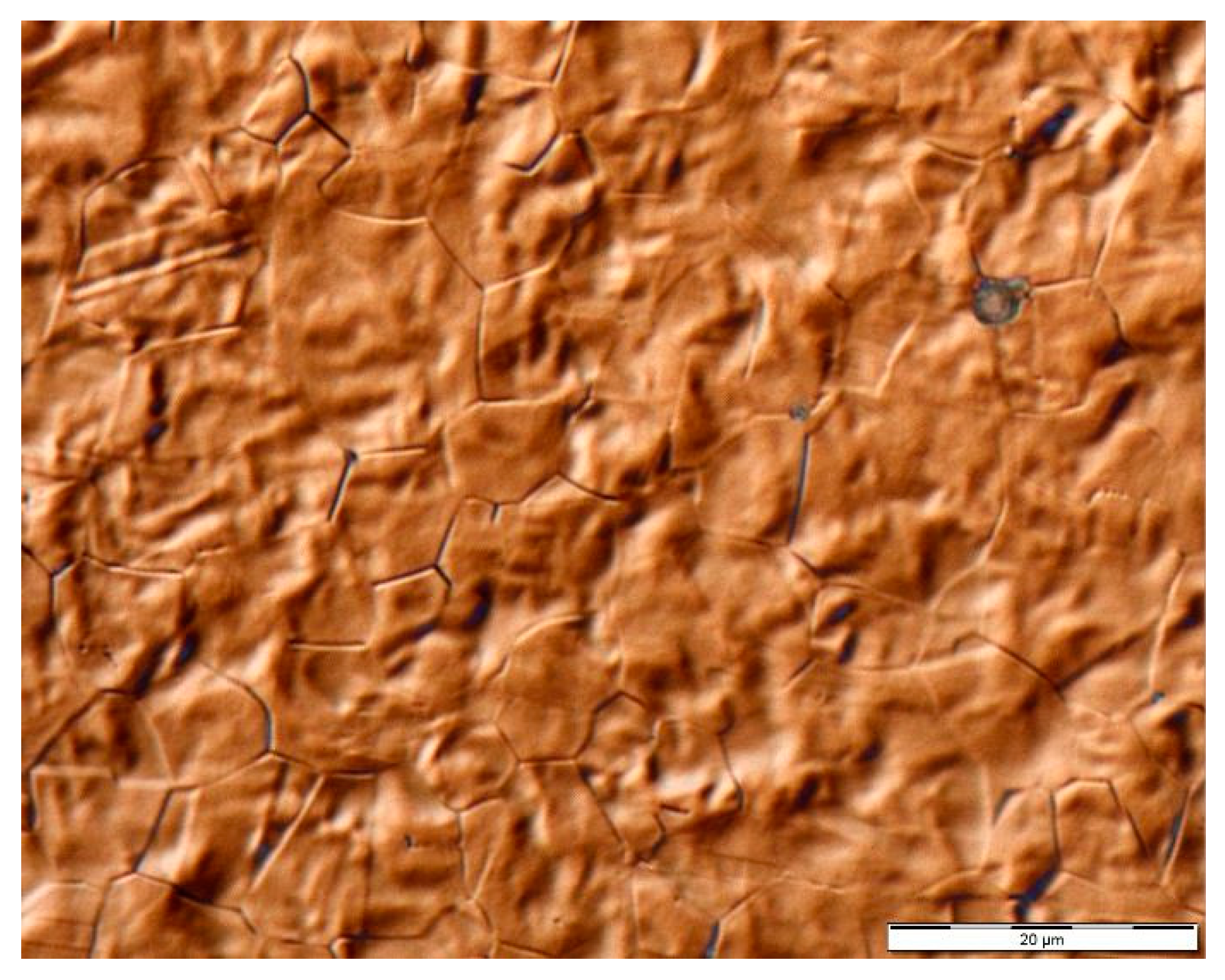
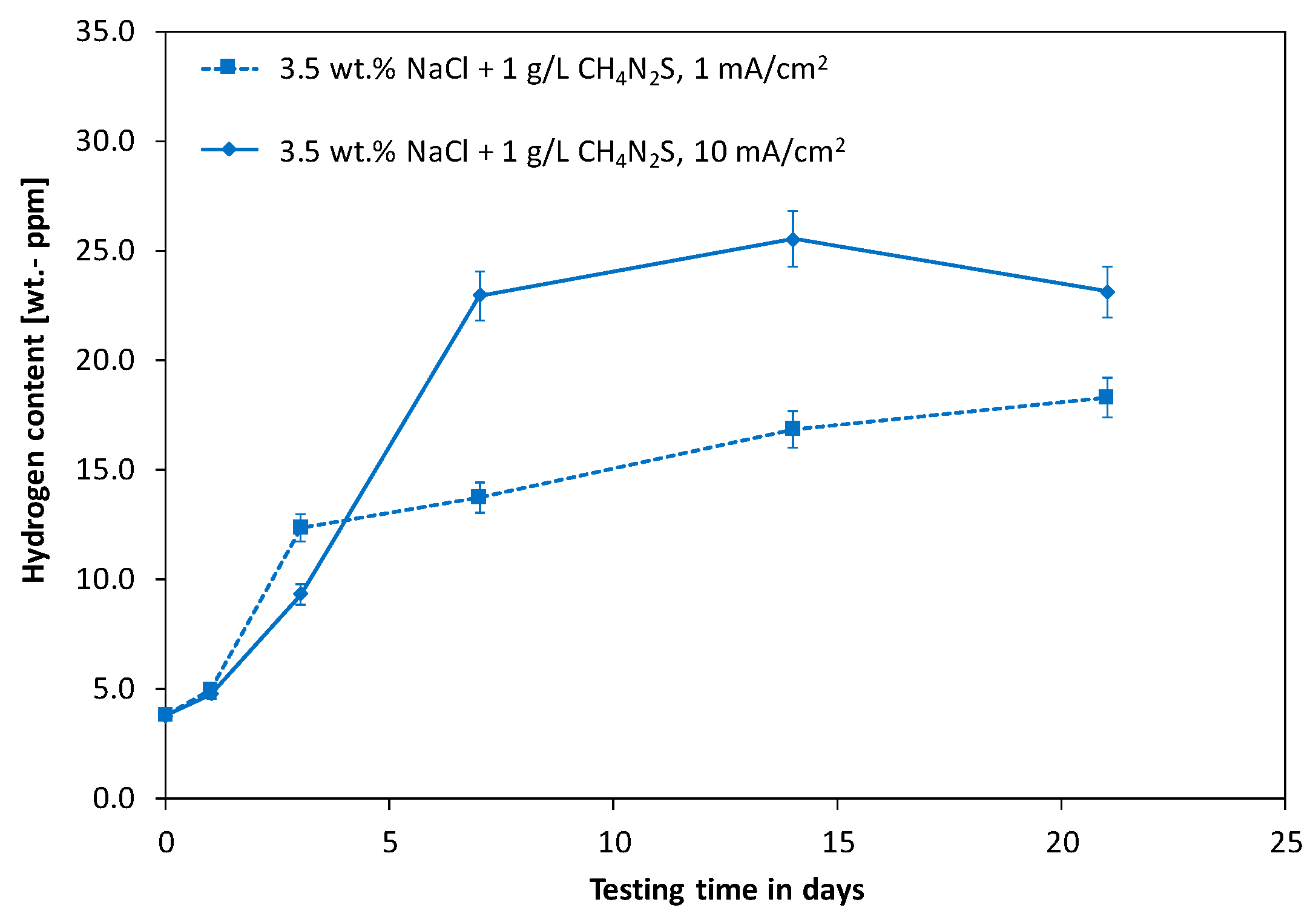
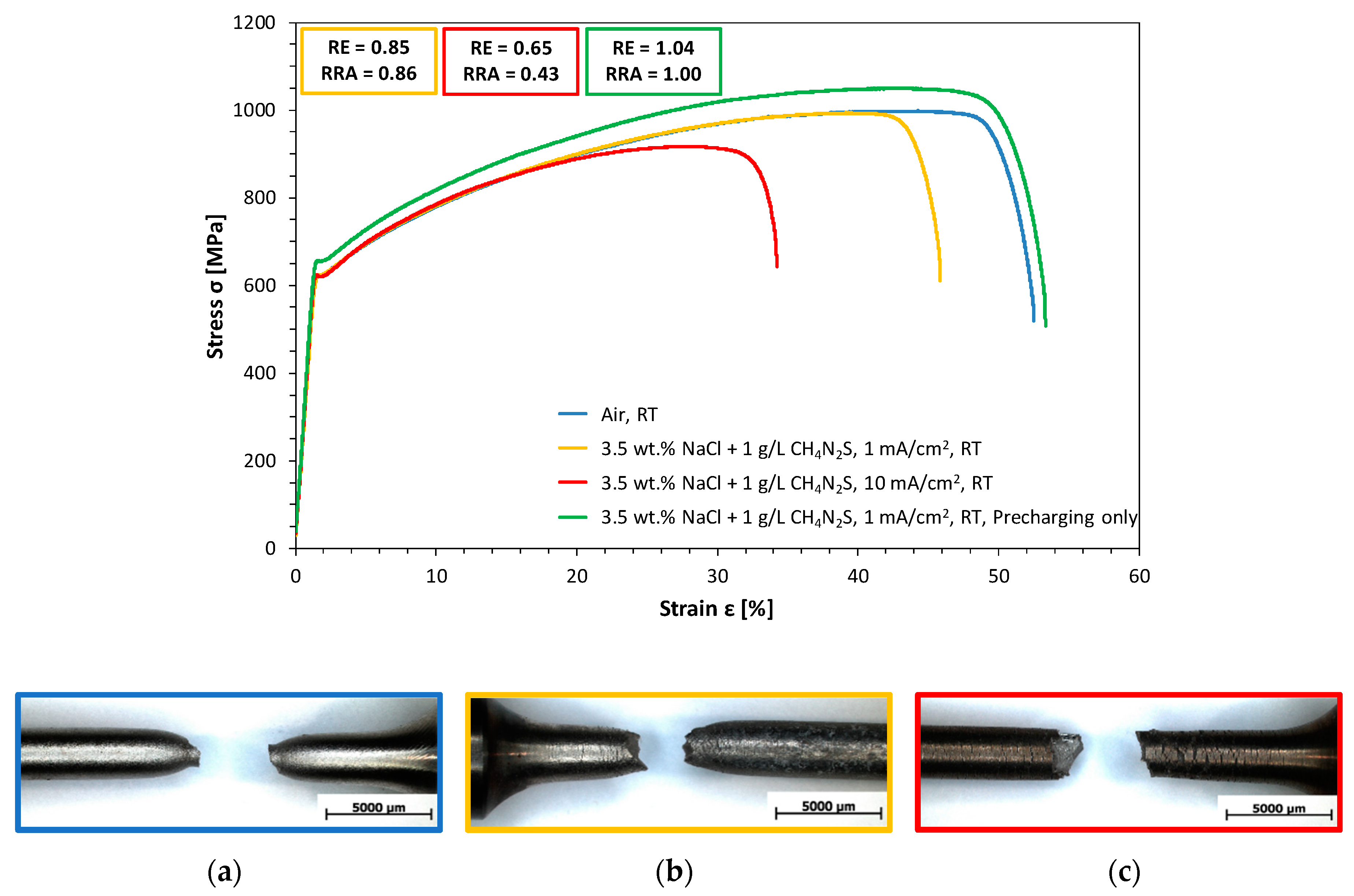

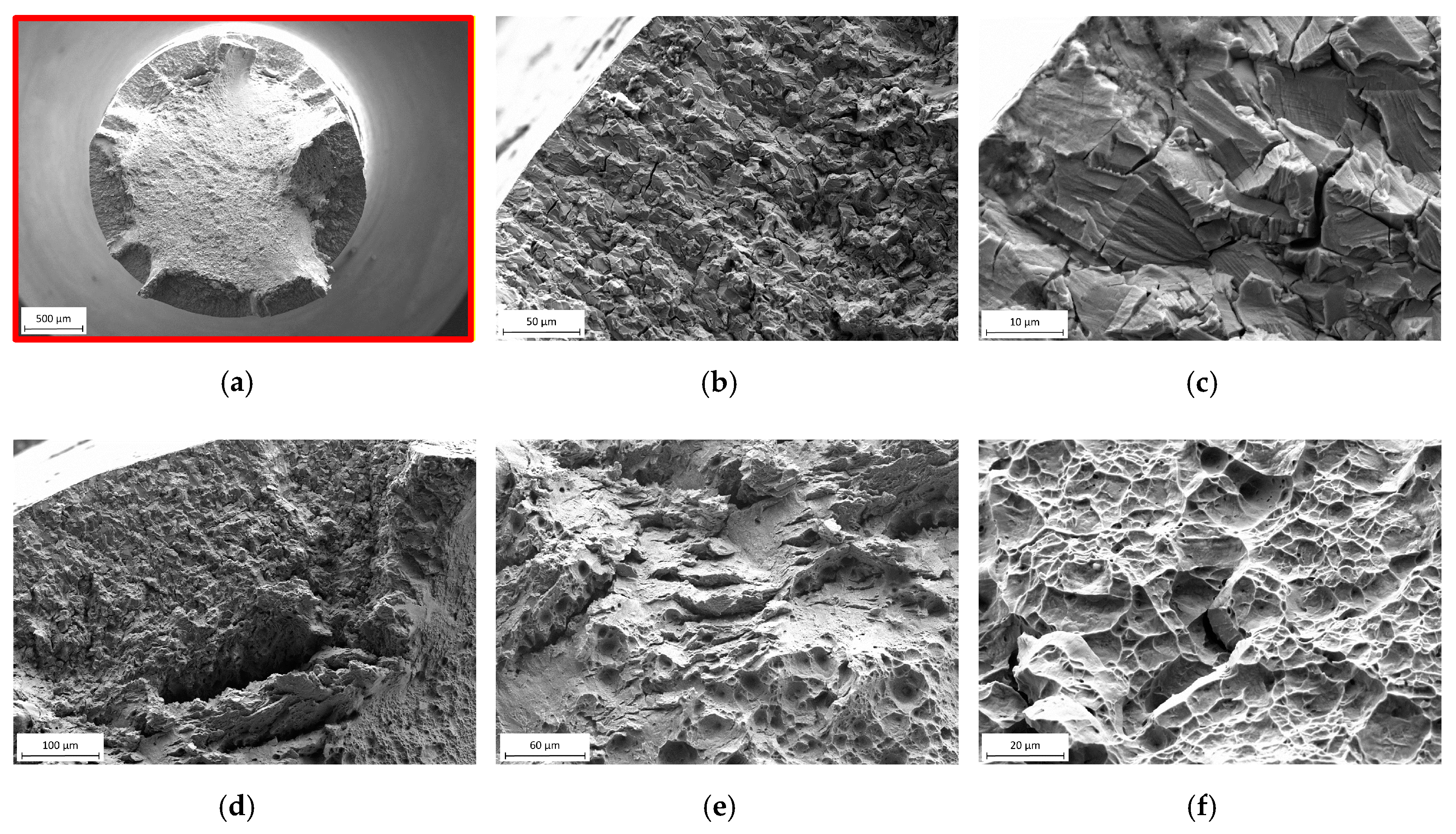
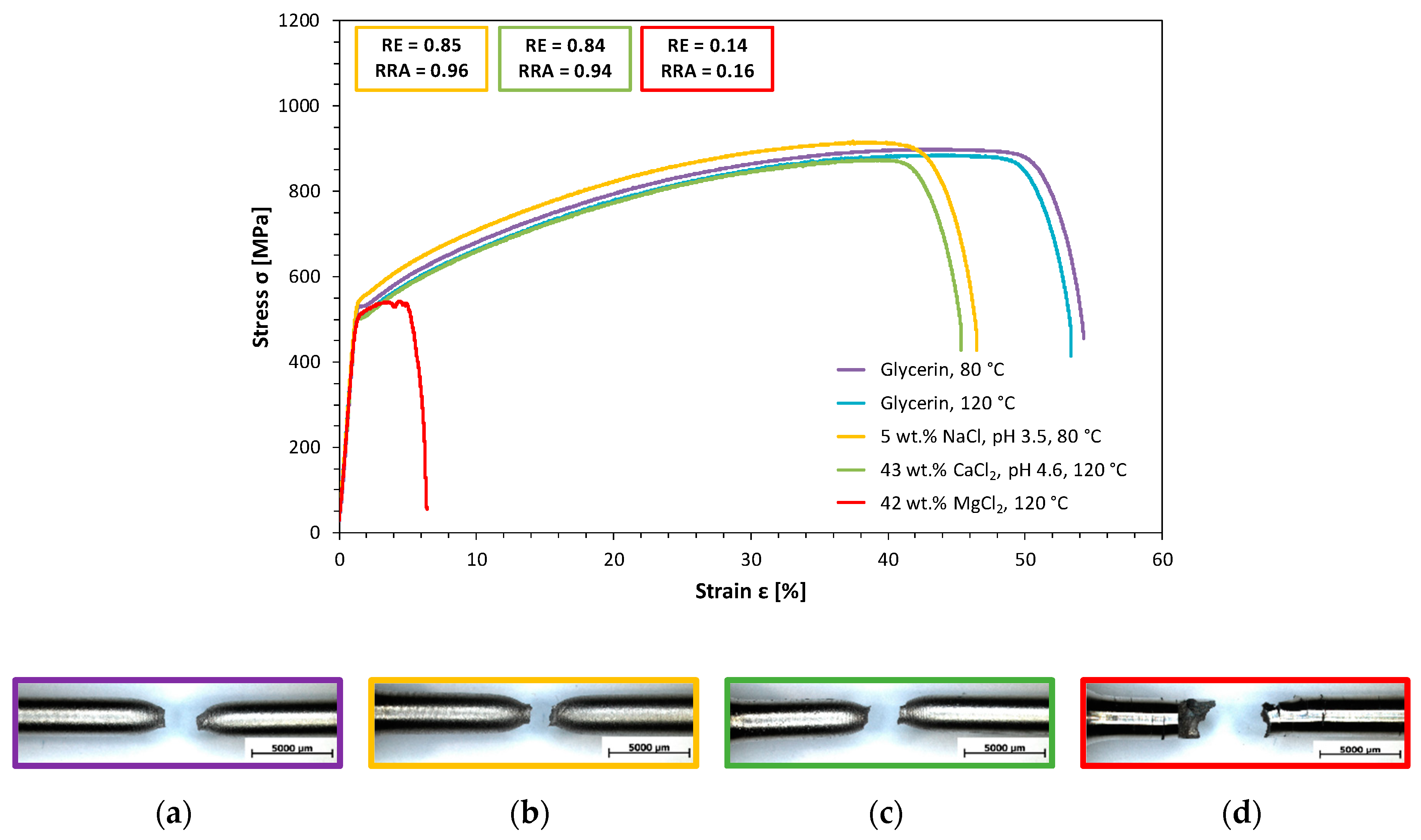




| Medium | Thiourea (g/L) | Current Density (mA/cm2) | Temperature (°C) |
|---|---|---|---|
| 3.5 wt.% NaCl | 1 | 1 | 23 |
| 3.5 wt.% NaCl | 1 | 10 | 23 |
| Medium | Precharging | Strain Rate (1/s) | Temperature (°C) |
|---|---|---|---|
| Air | 1 mA/cm2, 3 days | 2 × 10−6 | 23 |
| 3.5 wt.% NaCl + 1 g/L CH4N2S | 1 mA/cm2, 3 days | 2 × 10−6 | 23 |
| 3.5 wt.% NaCl + 1 g/L CH4N2S | 10 mA/cm2, 3 days | 2 × 10−6 | 23 |
| Buffered 5 wt.% NaCl, pH 3.5 | No | 2 × 10−6 | 80 |
| 43 wt.% CaCl2 | No | 2 × 10−6 | 120 |
| 42 wt.% MgCl2 | No | 2 × 10−6 | 120 |
| Medium | Precharging | Temperature (°C) |
|---|---|---|
| 3.5 wt.% NaCl + 1 g/L CH4N2S | 10 mA/cm2, 3 days | 23 |
| Buffered 5 wt.% NaCl, pH 3.5 | No | 80 |
| 42 wt.% MgCl2 | No | 120 |
| Medium | Stress (MPa) | Stress Ratio (-) | Time to Failure (h) |
|---|---|---|---|
| 3.5 wt.% NaCl + 1 g/L CH4N2S, 10 mA/cm2, 3 d precharging + continued charging during CLT | 744 | 1.2 | - |
| Buffered 5 wt.% NaCl, pH 3.5, 80 °C | 439 | 0.8 | - |
| 559 | 1.0 | - | |
| 679 | 1.2 | - | |
| 42 wt.% MgCl2, 120 °C | 439 | 0.8 | - |
| 559 | 1.0 | 179 | |
| 679 | 1.2 | 7 |
Publisher’s Note: MDPI stays neutral with regard to jurisdictional claims in published maps and institutional affiliations. |
© 2020 by the authors. Licensee MDPI, Basel, Switzerland. This article is an open access article distributed under the terms and conditions of the Creative Commons Attribution (CC BY) license (http://creativecommons.org/licenses/by/4.0/).
Share and Cite
Truschner, M.; Deutsch, J.; Mori, G.; Keplinger, A. Cathodic and Anodic Stress Corrosion Cracking of a New High-Strength CrNiMnMoN Austenitic Stainless Steel. Metals 2020, 10, 1541. https://doi.org/10.3390/met10111541
Truschner M, Deutsch J, Mori G, Keplinger A. Cathodic and Anodic Stress Corrosion Cracking of a New High-Strength CrNiMnMoN Austenitic Stainless Steel. Metals. 2020; 10(11):1541. https://doi.org/10.3390/met10111541
Chicago/Turabian StyleTruschner, Mathias, Jacqueline Deutsch, Gregor Mori, and Andreas Keplinger. 2020. "Cathodic and Anodic Stress Corrosion Cracking of a New High-Strength CrNiMnMoN Austenitic Stainless Steel" Metals 10, no. 11: 1541. https://doi.org/10.3390/met10111541
APA StyleTruschner, M., Deutsch, J., Mori, G., & Keplinger, A. (2020). Cathodic and Anodic Stress Corrosion Cracking of a New High-Strength CrNiMnMoN Austenitic Stainless Steel. Metals, 10(11), 1541. https://doi.org/10.3390/met10111541





